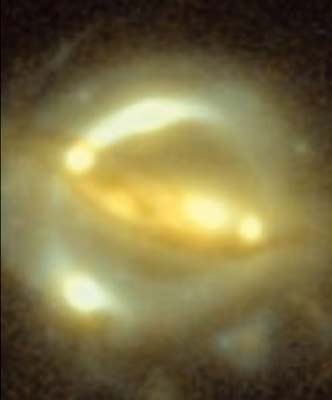
Hubble image of the gravitational lens B1608+656. In the centre is a pair of foreground galaxies that are gravitationally lensing a background galaxy, which appears as four bright spots circling the foreground galaxies.
Image credit: Sherry Suyu/Argelander Institut für Astronomie.
When two sources at various distances happen to be aligned on the line of sight, the gravitational field of the nearer galaxy distorts the image of the distant galaxy into multiple arc-shaped images (CERN Courier April 2008 p11). The distortion can even form a complete ring if the alignment is perfect and the lensing galaxy has an almost spherical shape. This effect is called an “Einstein ring” because the image distortion results from bending of the light path by the curvature of space–time around the lensing galaxy, as predicted by Albert Einstein’s theory of general relativity.
Gravitational lensing has proved a powerful tool to detect Earth-like extrasolar planets, measure the distribution of dark matter and discover the most distant galaxies (CERN Courier March 2006 p12, CERN Courier January/February 2007 p11, CERN Courier April 2008 p11). Now, Sherry Suyu of the Argelander Institute for Astronomy in Bonn and an international team of collaborators have demonstrated with a detailed study of the gravitational lens B1608+656 that gravitational lensing can also measure the age and composition of the universe with an accuracy that is comparable to other methods (Suyu et al. 2010). The study is based on work published a year ago and on radio-monitoring observations taken between 1996 and 2000 (Suyu et al. 2009, Fassnacht et al. 2002). The latter measurements by the Very Large Array in New Mexico allowed the determination of differences in the lengths of the bent light paths for each of the four apparent images of the background galaxy. These differences are inferred from the time delay of variations observed in each of the four views of the same lensed radio source located in the distant galaxy.
Apart from precise time-delay determinations, there is another difficulty to master before being able to derive accurate measurements of cosmological parameters by gravitational lensing: the modelling of the mass distribution of the lensing galaxy. This was particularly difficult in the case of B1608+656 because the lens is produced by a pair of galaxies, but it proved possible thanks to a high-resolution image taken by the Hubble Space Telescope. Finally, the team used a Bayesian statistical approach to develop a complete description of the lens by combining the Hubble image, stellar-velocity dispersion measurements and the time delays between the multiple images.
This detailed analysis of the gravitational lens B1608+656 over several years yields accurate determinations of cosmological parameters, especially when combined with constraints from the five-year measurements by the Wilkinson Microwave Anisotropy Probe and assuming a flat spatial geometry. The Hubble constant is determined to be 69.7 + 4.9/–5.0 km s–1 Mpc–1 and the equation of state parameter to be w = –0.94 +0.17/–0.18 (where w = –1 corresponds to a cosmological constant). These uncertainties are similar to those obtained with baryon acoustic oscillation data, showing that the gravitational-lens technique is now sufficiently mature to compete with other cosmological probes. In the near future, repeated surveys of the sky should detect several tens of suitable gravitational lenses for similar studies and hence further constrain cosmology through the careful analysis of the effects of space–time deformations.





